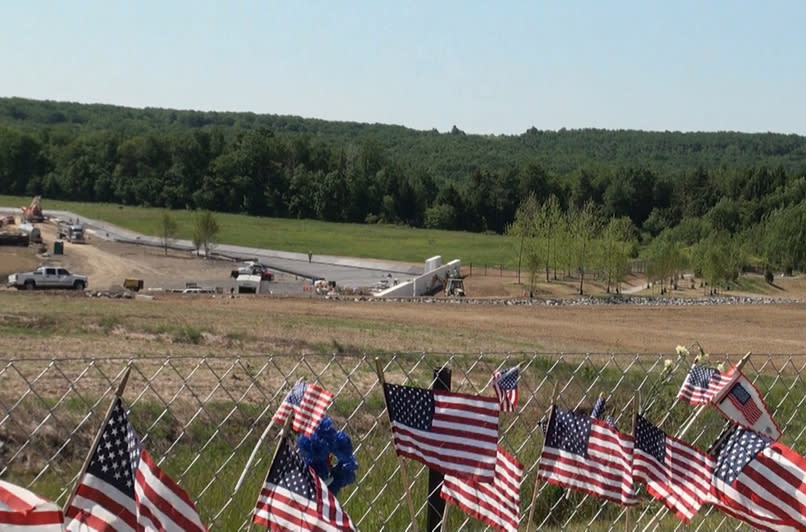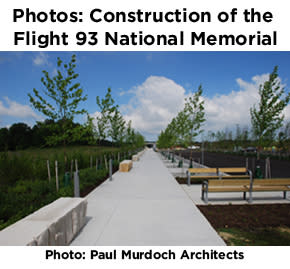 Yahoo 9/11 10th Anniversary
Yahoo 9/11 10th AnniversaryArchitect explains changes to Shanksville 9/11 memorial

On Sept. 11, 2001, two planes crashed into the World Trade Center in Manhattan. A third hurled into the Pentagon in Washington, D.C. But a fourth plane, United Airlines Flight 93 from Newark, N. J., to San Francisco, never made it to the hijackers' destination.
The 40 passengers and crew members realized their flight had been hijacked, and from air phones they learned about the attacks on the other sites. According to accounts from the phone conversations, the group took a vote and vowed to take back their plane, which crashed into a field in a remote, rural area near Shanksville, Pa., never to reach its possible target, the U.S. Capitol in Washington, D.C. -- only 20 minutes flying time from the crash site.
In 2005, relatives of those who died on Flight 93 helped select Paul Murdoch's winning design for a memorial out of some 1,000 entries. The remote area proved a challenge. It is a former coal-mining site that required major soil and water cleanup. There also were landowner conflicts and a controversy over a crescent in the design that some took to be a Muslim symbol in the original plan.
To quiet debate, the design was altered from the original crescent shape, and the project eventually will feature a 93-foot-high Tower of Voices containing 40 wind chimes -- one for each passenger and crew member who died -- and 40 groves of red maple trees that will line a circular walkway that follows the natural bowl shape of the land, a result of the surface mining.
The $62 million plan includes 2,200 acres. Visitors can follow the flight path, and in phase one, they will view a slab of white marble inscribed with the names of the 40 victims. A concrete structure will form a gateway for visitors, separating the parking area and the memorial plaza, which extends along the edge of the crash site.
The project is part of the National Parks System, and $52 million has been raised so far. The money has come from the federal and state governments, as well as from 72,000 individual contributors. To support the completion of the design, a campaign to raise $10 million in private donations is in full force.
Patrick White, an attorney whose cousin Louis "Joey" Nacke II died in the crash, sits on the development advisory group for the Flight 93 memorial. After recently returning to his home in Naples, Fla., from the site at Shanksville, he marveled at the success of the design. He called the area where the plane crashed "very powerful." White added, "The design succeeds through its natural focus on the debris field, which is the sacred ground, the cemetery, essentially, for our lost love ones."
Paul Murdoch, of Los Angeles-based Paul Murdoch Architects, who was on-site to view the progress of the project, discussed phase one of the Flight 93 National Memorial, which will be unveiled on the 10th anniversary weekend of Sept. 10 and 11.
What drew you to come up with a design for the competition?
Well, I think, first and foremost, it was wanting to do something after the attacks and offering something as a tribute as a designer. So that was a key motivation. Really, what those 40 people did on the plane was inspiring. So we wanted to try to do something to honor that. And I grew up outside of Philadelphia. I've been in California for 30 years now, but I spent time in this part of the country camping and canoeing. It's a beautiful landscape. I remembered it well. The combination of the place and wanting to do something to honor the 40 people was the motivation to submit something in the competition.
It must feel like a huge accomplishment to get where you are now.
It's a very challenging project for lots of reasons. Anything like this takes time. It's certainly an important, big step for full implementation for a project. It's a very significant threshold for the project -- for the 10th anniversary. It's a significant amount of work that's been done for the first phase. So people start to get a feeling what we're doing overall there; that's important.
How are things coming along?
Right now, there's some finishing touches, some of the planting installed; there's a visitor shelter that's just being completed now; there's a little bit of grading going on, some soil stabilization of the area, where they expect to have the ceremony on the 10th and 11th. Most of it is in the final stages for completion for the things that have been done.
What will be open in the first phase is just a small shelter. The entry road will be finished. So you come off the state road and then you can drive roughly two and a half miles through the site, which used to be coal mining. You finally arrive at this big bowl-shaped space. And there's a ring road that will go around that space in a circular shape. And most of the grading for that big field has been done where the groves of trees will go in the next phase. And that road will cross the wetlands on a new embankment and arrive at a parking lot just down at the edge of the crash site.
That's what a lot of people want to see when they first arrive: Where did the crash occur? They can go out there -- you can see that down the hill -- but they can come back and they can go either to the visitors center, or they continue along this walk way. … A lot of times a year [because of foul winter weather] people won't be able to make that walk. The walkway and road curve around the field to eventually arrive down at the crash site.
Has your firm designed other memorials?
This is the first one that we've done.
What's the experience been like for you? You've worked on major projects, like the Staples Center Arena, but this is an emotional issue for people.
That's an important point. It's important to recognize it's not a Civil War-era memorial. It's something that happened 10 years ago in a highly advanced piece of technology. It's a highly modern event.
Can you describe the idea behind the memorial design?
It's trying to recognize the place where it happened -- we're there. We're at the place where the plane crashed. We're not on the Mall in Washington, D.C. This is where it occurred. So it recognizes the site as well as the event. That forms the dialogue.
The place is very serene. It's a beautiful landscape, it's a natural environment. Even though a lot of it is restored mining. The site's been used very heavily. What's coming back is very much a park. It's a place we want a serene quality for reflection, and memory and commemoration, and, on the other hand we need to recognize what happened there, as a type of battlefield and a place where this very violent act occurred. So the qualities of the place inform the expression of the memorial as well.
I read that the original design was a crescent, but that was changed after some criticism about the use of that symbol in the design. [Critics of the design perceived the shape to mimic an Islamic symbol.] Were you surprised by the controversy?
It was a surprise. The intention was to create a monumental gesture of embracing that place. If you think of a tragic event, or something that happens to a friend of yours, and you see them, one of the things you do, is embrace. We took that very personal idea and did it at a scale that is in keeping with the land -- in a heroic scale commensurate with a national memorial commemorating an event.
We called that element "crescent of embrace," giving a whole new meaning to the form. Some folks didn't take it that way. They read other symbolism that was, of course, not at all what we had in mind. To eliminate any kind of conflict, we ended up adding more trees to that area so it's more fully a circle.
Have you noticed any change in the attitudes and perception of the memorial project? What, specifically, is different from back then and now?
I think the flare-up was pretty peripheral. The thrust has been with a lot of support to get this thing in the ground and open. That's where everybody has been putting their efforts. That's where the support has been. We're enjoying the fruits of that focus, not some peripheral nonsense. I think it's important to recognize that there are a lot of challenges to do something like this. So that we're opening this important phase 10 years after the event is actually an achievement. It seems like a long time coming, but I think it's a big first step.
This is an interesting time to construct a memorial for such a recent event. What do you hope visitors get out of it, now and in the future?
Personally, I would like to see a certain reverence and awe at this place, that it would help instill that. What we've tried to do is create a certain diversity of experiences; that's why we call it a memorial landscape.
People will take different things away from it. That's important. It's not an overly programmed message. Some of the values there should be self-evident, and should be present and strong, but it will mean different things to different people. It will affect people in different ways, and what I would hope is it does affect people in their own lives. That's how the place will stay alive. Not by becoming a myth or a story, but to stay alive for people for future generations.
What has been the most rewarding parts of the process?
I guess the reward is that the public is finally going to experience it. That's ultimately what's gratifying here, is that the families of the passengers and crew have something tangible they can now see that commemorates their loved ones, and that also the public can come and pay their respects and learn from what happened there. I truly think this is one of the places that each American should try to visit in their lifetime.
Share your 9/11 memories with us on Twitter - #911remembered


